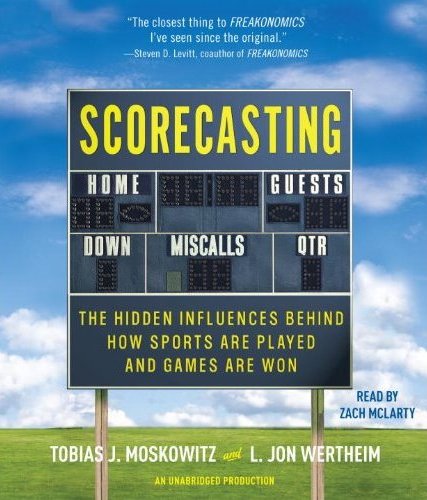What happens when one of the most renowned finance professionals in the country gets together with one of the mist intelligent sports writers in the country? They create a perception of sports that has never been heard before.
In Scorecasting finance scholar Tobias Moskowitz and sports journalist L. Jon Wertheim attempt to answer questions that many casual sports fans may think they already know the answer to.
The premise of the book is to study the “myths” about sports that are heard daily on television, radio, and surrounding the water cooler to see if there is actually any truth to these ideas. With the 24 hour sports news cycle now in play, it is becoming harder than ever for people to put a new spin on the same old story, which usually leads to the rehashing of tired clichés.
Scorecasting will remind readers of Michael Lewis’ famous work Moneyball mainly because it brings to light an entirely new way of looking at sports. The authors examine many seemingly well-known sports ideas such as how much advantage a home field actually gives a team, as well as where that advantage comes from. Not only are their conclusions interesting, and most of the time unexpected, but they actually have hard statistical data to back up their claims.
Their findings could be construed as somewhat controversial especially for those who work in either officiating or a league office. For example, the authors’ research indicates that the strike zone on a 3-0 pitch is actually 188 square inches larger than it is on 0-2 counts. While it is well known that every umpire has their own strike zone, one would like to think that the strike zone is at least consistent while that umpire is behind the plate. Apparently this is not the case.
Continuing their assault on the umpires of the world, the research also indicates that the umpire-monitoring technology that has been implemented in professional baseball over the past few years is actually helping to ruin home field advantage for teams. At least this makes the All Star Game outcome a little less important.
Cubs’ fans may be either rejoiced or distraught to find that the book illustrates how they are actually less unlucky than the average baseball team. If this is the case, imagine how the fans of the other teams must feel.
The authors also examined why there have been fewer hitters to hit .299 in the Majors than those who have hit .300 and they even attempt to examine if those players could have possibly been more valuable than the ones to hit the well-known milestone.
What is mentioned above is just a small portion of the topics the authors cover in Scorecasting. The work is truly riveting and while it is statistically driven, the reader will not feel like they need to put their head on their desk like the last time they read a book with this much statistical support. However, the reader will feel the need to keep on turning the pages to see what answer to a well- known and overused sports cliché the authors are going to come up with next.
Anyone can write a book that makes outrageous claims, but rarely does a work come along that backs those claims with hard data, and then explains where the data came from to further bolster the case of their point.
This book will not only entertain those who pick it up, it will also help them better understand the games they love. Chances are after reading this book; a reader may find themselves in some of the most sophisticated bar room sports talk ever to occur.
Overall Rating: 4.25/5












2 Responses
Sounds like a great book to pick up. Definitely going to put this one on my list to read. Thanks for sharing your thoughts on it with us.